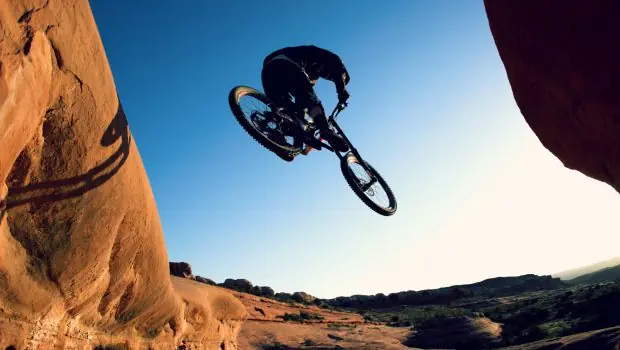
There are no ifs, ands, or buts about it. We've double and triple fact checked it and jumping is one of most fun things you can do on two wheels. Imagine, smokin' down the trail, skimming over rock gardens, floating over roots, clearing gaps? braaaap! To top it off, not only is this a super cool skill that will impress all your friends, it's actually quite practical! Why torture yourself with a gnarly rock outcropping when you can easily fly over it?
More: How to Ride Faster and Smoother on the Trails
So that you, too, can enjoy a bit of the braaap that comes with catching air (and landing safely), I've broken jumping down to six easy to follow steps?
1. Inspect and Visualize
Prior to attempting the jump, get off your bike and inspect the jump and the landing. Figure out what the best angle for approach is and exactly where you'd like to land your bike. Then, visualize yourself successfully completing the jump. I have a simple rule that keeps me safe: If I can't visualize myself successfully completing the jump, I don't jump it. Perhaps the jump is too big? Or the face too steep? Or you're unsure of the landing? Skip it and work on jumps you feel more comfortable with and work your way up to the more difficult jumps.
Once you've visualized yourself jumping successfully and have determined the best line, it's time to jump.
2. Get Ready
Ride towards jump in your ready position. Stay focused, present, and positive — a little positive self-talk is a must here. As soon as your front wheel gets to the face of the jump, compress your bike into the ground. Your elbows should be out, and your knees bent.
Note: You don't need suspension on your bike to compress it — compressing is merely the action of throwing your weight downward.
More: The Importance of Positive Self Talk in Mountain Biking
3. Take Off
Just prior to reaching the lip of the jump, explode! This explosion is a quick pull up with your arms and legs. If your timing is correct, you will sail right over it. If you are riding uphill, throw your weight forward as you go over an obstacle. If you are riding downhill, you will need to shift your weight backward as you go over it.
Pro Tip: THE IMPORTANCE OF COMPRESS AND EXPLODEThe biggest mistakes I see riders make when trying to jump is the lack of compression and explosion just prior to the jump. If you don't compress and explode, your bike will behave very similarly to a rock. Gravity will get the best of you (and your bike) and you will promptly get pulled back down to earth a la Newton's apple. That's not typically the desired result. So, throw your weight down and then explode up like you mean it. Get aggressive. Grrrr.
4. Landing
Once you're flying, relax and resume your ready position and keep looking forward to your intended landing spot. Push your bike down onto your desired landing spot to increase your traction. Your arms and legs are your primary suspension when landing so keep them relaxed enough to absorb the impact, but sturdy enough so that you don't lose control of your bike.
Pro Tip: HOW TO LANDIf the jump has a descending landing, land on your front wheel right before your rear wheel. This will give you more directional control and smooth out the landing. If you land rear wheel first on a descending landing, the front of the bike is likely to pivot forward and slam the ground thus thrusting your weight abruptly forward and potentially over the front of the bike.
If you landing is flat, land with you rear wheel first. Landing on flat surfaces is more abrupt than landing on a descending landing. Landing on your rear wheel first allows you to use your legs to absorb the majority of the landing force. Relying on your suspension solely tends to cause a hard landing and a potential for loss of traction.
5. Practice
You'll find that if you add more speed, you'll fly further and if you add more lift, you'll fly higher. It'll take some time to calibrate your brain, body and bike to take off and land precisely as you intend. Experiment with controlling your landing, both wheels, rear wheel first, front wheel first and your distance and height.
Table-top jumps are the most forgiving and one of the best places to take your jumping skills to the next level. If you short a table-top (don't make the landing), there isn't much of a consequence, just land on the 'top' of the jump. Unlike a double where you have to make the landing spot or you risk casing your bike
6. Have Fun
As your confidence (and skill) increases, pick bigger obstacles, going up and down hill while jumping, experiment with your airtime and HAVE FUN! If you'd like to learn more and practice jumping in a safe, controlled environment – I recommend you attend a jumping fundamentals mini-clinic.
More: Mountain Biking in National Pakrs? Hell Yes
. Ready to ride? Search for a cycling event.
Ready to ride? Search for a cycling event.

